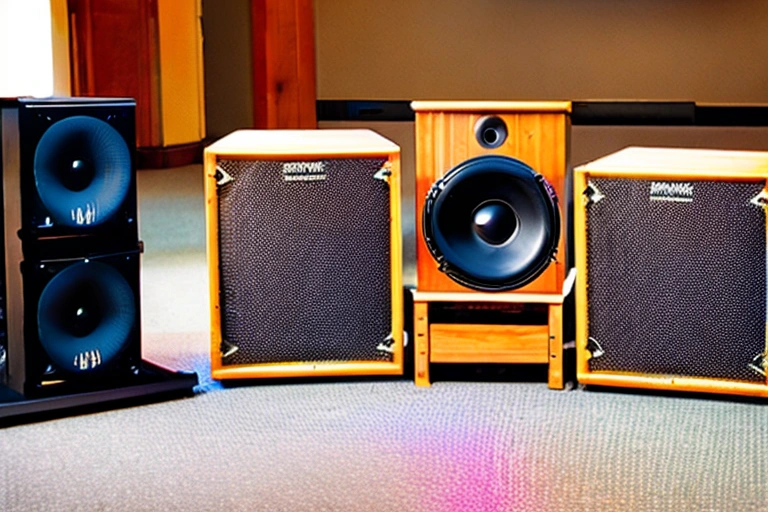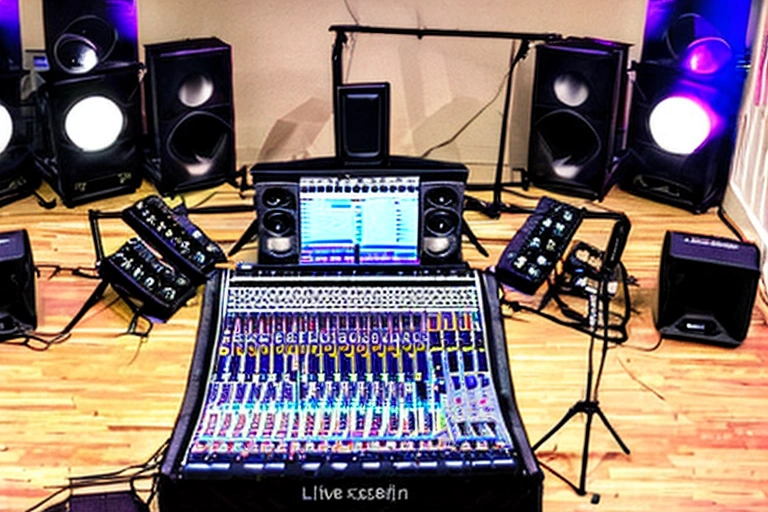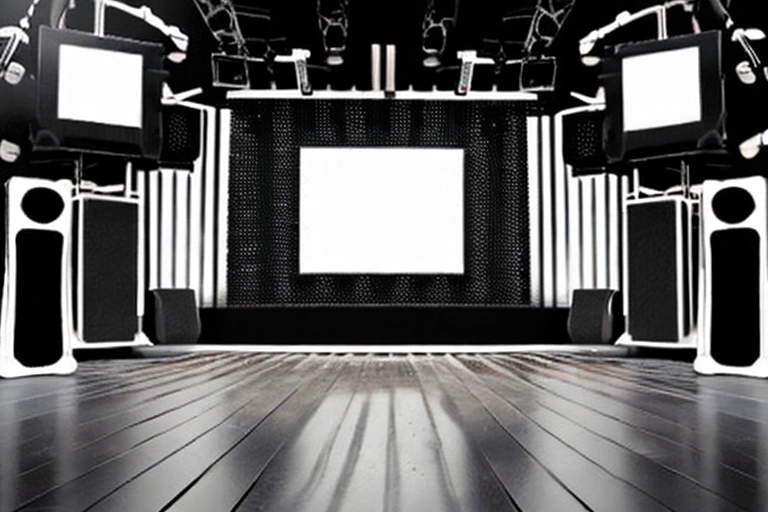Are you planning a daytime concert but unsure how to create optimal sound? Then this blog post is for you! Learn the best techniques for setting up sound equipment to ensure your concert is heard loud and clear. We’ll provide step-by-step instructions on ensuring your concert goes off without a hitch. Keep reading to find out more!
- Choosing the Right Venue
- Selecting Speakers and Amplifiers for a Daytime Concert
- Setting Up Microphones for Vocals and Instruments
- Essential Cables, Connectors, and Adapters Needed
- Ensuring Safety Precautions are in Place
- Mixing Control: How to Balance Different Instruments or Voices
- Sound Check Tips Before Going Live
- Troubleshooting Common Problems During a Concert
- Dealing with Interference from External Sources
- Position of Monitors For Optimal Audio Quality
- On-Stage Monitoring Strategies for Musicians
- Addressing Acoustical Challenges When Setting Up Sound
Choosing the Right Venue
When choosing a venue for a concert, it is important to consider the size of the audience and the type of sound system that will be needed.
If the concert is to be held in a large hall or arena, then a PA system will be necessary to amplify the sound. If the concert is to be held in a smaller setting, such as a church or school auditorium, then a sound system with built-in speakers may be sufficient.
It is also important to consider the type of music being performed. If the concert features rock or pop music, then a louder sound system will be necessary to capture the audience’s energy. If the concert features classical music, a softer sound system will be more appropriate.
Selecting Speakers and Amplifiers for a Daytime Concert
Selecting speakers and amplifiers for a daytime concert can be tricky. You don’t want to over-power the sound system or unnecessarily amplify low-frequency sounds, which could cause distortion. There are also many factors to consider when choosing equipment, such as size and wattage ratings. Here are a few tips to help you select the right speakers and amplifier for your event:
Start by assessing the space where your concert will be taking place. Do you have a large hall that can handle multiple stages with sound systems? Or is your venue limited in floor space? If it’s a smaller space, it may be best suited with 2-3 smaller speakers per side of the stage rather than one massive speaker.
Next, think about what type of music you’ll be playing. Will it predominantly be rock or pop songs? This will help determine which speakers would work best for your genre of music. Once you know what type of music is being played, think about how loud the instruments will be on stage. Are there certain members of the band that need extra amplification? Once you’ve determined all these factors, start shopping for speaker kits and amplifiers that fit your needs!
Be mindful when purchasing equipment not to lose too much money. Many times cheaper options will simply produce lower quality sound without meeting all of your needs – like having enough power to handle large crowds without distortion or making sure each speaker produces clear vocals during an acoustic performance.

Setting Up Microphones for Vocals and Instruments
When setting up microphones for vocals and instruments, it is important to understand how they work and how to adjust them. Different microphones have different pickup patterns, meaning they pick up sounds differently. It is also important to match the mic preamps on a mixer or amplifier to the microphone’s sensitivity rating. For example, if you are using a dynamic microphone, you should use an amplifier with a low sensitivity rating; this will help keep the signal from being distorted.
Once your microphones are set up and tuned, it is time to test them out in situ. Ensure that all potential electrical noise sources – like fluorescent light fixtures – are shielded from your mics by appropriate furniture or cables before starting your performance. Then, start singing or playing into each microphone one at a time and listen for any unnatural-sounding pops or clicks (this could be caused by improper placement of the mic). If everything sounds good on stage, congratulations! You’re ready to rock!
Essential Cables, Connectors, and Adapters Needed
Choosing the Right Equipment
Sound for a live concert can be a daunting task, but with the right equipment and cables, it can be a breeze. Here are the essentials you’ll need:
Microphones: A good microphone will capture your voice and any instruments you’re playing with precision. Look for a microphone that is cardioid-patterned, which will reduce background noise.
Sound System: You’ll need a sound system to amplify the sound of your microphones and instruments. Look for one that has enough power to handle the volume of your music and has a built-in mixer to adjust levels.
Cables: You’ll need cables to connect your microphones to your sound system and instruments to your microphones. Choose cables that are of high quality and are compatible with your equipment.
Connectors: You’ll need connectors to connect your cables to your equipment. Look for connectors that are of high quality and are compatible with your equipment.
Adapters: You’ll need adapters to connect different cables to different connectors. Look for adapters that are of high quality and are compatible with your equipment.
Setting Up the Sound System
One of the most important aspects of setting up sound for a live concert is selecting the right cables, connectors and adapters. Here are some basics you will need:
- Sound Cards and Headphones/Speakers
- Mic Cables
- Power Cords and Adapters
- Interconnect Cables
- Monitor Speakers or Monitors
- Speaker Cable TV Antennas
To get started, connect your speakers to your computer using USB power cords or AC power adapters compatible with your speakers’ requirements (check the documentation that came with your speakers). Once connected, you’ll need to install audio recording software on your computers, such as Audacity or RealPlayer, so you can record your live performance.
Next, connect your sound card to your computer using the appropriate cables. Be sure to install the drivers for your sound card before connecting. You can find the drivers on the manufacturer’s website or in the installation CD that came with your sound card.
If you’re using a laptop, you’ll need to connect your laptop’s microphone to the sound card using a mic cable.
Finally, connect your headphones or speakers to your sound card. You can do this using either an audio cable or a headphone jack on the front of your sound card. Ensure your speakers are turned on and plugged into an outlet before connecting your headphones or speakers.
Once everything is connected, you’re ready to start recording!
Testing and Troubleshooting
There are a few essential cables, connectors, and adapters needed for setting up sound for a live concert. Microphones need cables to connect them to the mixer, and speakers need cables to connect them to the PA system.
To test sound, use a cable tester. This can be plugged into the mixer or PA system and will test the audio signal. If there is a problem with the audio signal, it will be indicated by a blinking light. Once the sound is tested and working, connect the cables properly.
Optimizing the Sound for a Daytime Concert
To give your audience a great sound at a daytime concert, you will need to optimize the audio for different areas. For vocals, you will want to use cardioid mics to focus on the singer and away from other instruments or audience members. This will help keep the vocals clear and ensure they are not drowned out by background noise. Additionally, use hybrid capsules if possible, as they provide a good compromise between sensitivity and intelligibility. When it comes to speakers, use smaller ones to avoid overwhelming the listener with too much sound. Additionally, make sure to orient them correctly so that listeners can best hear the music.

Ensuring Safety Precautions are in Place
Sound is one of the most important aspects of a successful concert. Ensuring that the sound is perfect for the audience is essential to keeping them entertained and safe. There are a few things that you can do to ensure that your concert goes off without a hitch.
First and foremost, make sure that you have the correct sound equipment. You’ll need microphones, speakers, and amplifiers to properly set up your sound. Make sure that all of your equipment is in working order and that you have the necessary cables and connectors.
Next, make sure that you have a sound check. This will help you to ensure that your sound is perfect before the concert begins. During the sound check, check your levels, EQ settings, and overall mix.
Finally, take safety precautions into account when setting up your sound. Make sure that there are no sharp edges or objects in the area where your speakers will be placed. Additionally, ensure that there are no obstructions in the path of the microphones.

Mixing Control: How to Balance Different Instruments or Voices
Mixing control is balancing different instruments or voices to create a cohesive sound. It can be difficult to balance, but with a little practice, you can achieve a great sound for your live concert.
The first step in mixing control is understanding your equipment. Each instrument has its own sound and needs to be heard to create a cohesive mix. You also need to consider the size of the venue and the type of audience you are playing to. For example, if you are playing at a small club, you may want to mix your instruments more closely, so they are all audible. If you are playing at a large arena, you may want to mix your instruments more evenly, so they are more distinct.
Once you have determined the type of mix you want, it is important to set up your equipment. Make sure all your instruments are plugged into the correct inputs and outputs and that your levels are properly balanced. Once everything is set up, it is time to start mixing!
Start by listening to the entire mix and making sure everything is balanced.
You may need to adjust levels or EQs to get your desired sound. Once everything is balanced, it is time to start adding elements into the mix. Start by adding vocals or instruments that will be front and center. Once those elements are in place, add other instruments or vocals that will be mixed lower. Finally, add background elements that will help fill out the soundscape.
Once everything is mixed, it is time to listen again and make any final adjustments. Remember: mixing control is an art, so there will always be room for improvement!

Sound Check Tips Before Going Live
Soundcheck is an important part of any live performance. Not only does it allow you to make sure that your audio sounds good, but it can also help you to get a feel for the crowd and the stage. Here are some tips for sound check:
- Make sure that your audio equipment is in good condition. If there are any problems with your sound system, you will not be able to perform your best.
- Make sure that your microphone is properly adjusted. If it’s not in the right position, you cannot capture the right sound for your vocals or instruments.
- Test out different audio settings on your mixer. You may want to experiment with different levels and frequencies to find the perfect balance for your performance.
- Make sure that all of your cables are connected properly. If there are any loose connections, they will cause noise in your audio mix.
- Get a feel for the crowd and the stage. Once you have tested your audio settings, take a few minutes to understand how the crowd reacts and how the stage looks from where you are standing. This will help you to adjust your performance accordingly.

Troubleshooting Common Problems During a Concert
If you’re having trouble with sound during your live concert, there are a few things to check first. Make sure your venue is set up correctly, that all of your equipment is working properly, and that you have the audio levels adjusted correctly. If everything looks good on paper, but the sound still isn’t coming through well, look for any cables or wires that may be interfering with the signal. Lastly, ensure your audience is loud enough – if they aren’t cheering and clapping along enthusiastically, you won’t be able to hear yourself or the other performers!

Dealing with Interference from External Sources
Enhancing Sound Quality
Interference from external sources can be a major problem when trying to record or broadcast a live concert. There are a few things that you can do to minimize interference and improve sound quality.
First, try to find a location free from any electrical interference. This includes power lines, metal objects, and other electronic equipment. If you can’t find a free location, try to use a shielded microphone. This will help reduce interference from outside sources.
Second, use high-quality audio equipment. This will help reduce interference and improve sound quality.
Finally, try to use low-latency audio technology. This will help reduce the amount of interference and improve the sound quality.
Setting Up for Outdoor Venues
If you plan to hold a concert outdoors, be prepared for interference from external sources. For example, when the sun is shining brightly, it can cause interference with your sound equipment. Likewise, if there are any large trees or other structures nearby, they can also cause problems.
To avoid these issues, it is important to set up your sound equipment in a way that minimizes interference. Additionally, you will need to ensure that your sound equipment is properly shielded from external sources of interference.
Troubleshooting Tips
External sounds can interfere with a live concert, making it difficult to hear the music. There are a few things you can do to minimize the effect of external sounds on your audio:
- Have an intact and clear sound system. The better quality of your audio equipment, the less likely it is that outside noise will affect it.
- Make sure all cables are tucked away and out of sight. Cable TV wires and power lines often emit electromagnetic fields (EMFs), which can become interference sources near the high-quality audio gear. Keep cords neat and tangle-resistant, so they won’t create interference problems.
- Try using earplugs or headphones during loud parts of the concert if you’re having trouble hearing the music. Earplugs can help to reduce outside noise while you listen to music, and headphones can block out other sounds so you can focus on the music.
- Turn off all electronic devices in your vicinity before the concert begins. Devices like cell phones and laptops often emit EMFs, which can interfere with the sound quality of your audio equipment.
- Make sure your microphone is properly positioned. Microphones can pick up external sounds and amplify them, making it difficult to hear the music. Make sure your microphone is placed close to your mouth so you can capture the sound of the band perfectly.

Position of Monitors For Optimal Audio Quality
If you are looking to set up sound for a live concert, it is important to consider the position of the monitors. Monitors should be placed as close to the performers as possible to ensure optimum audio quality.

On-Stage Monitoring Strategies for Musicians
Live music is an experience that can be enjoyed by all, but musicians must have the best possible audio quality to provide an enjoyable show for their audience. This guide will outline some on-stage monitoring strategies that will help musicians achieve the best possible audio quality.
The first step in achieving optimal audio quality is to position your monitors correctly. Musicians should place their monitors as close as possible to the front of the stage but not so close as to interfere with the audience’s view. It is also important to place your monitors at a height that is comfortable for you but also high enough so that you can hear all of the instruments clearly.
To ensure that your monitors provide an accurate representation of the sound onstage, it is important to use a good audio monitoring system. A good audio monitoring system will allow you to hear all of the nuances in the sound and will provide accurate feedback about how your sound is affecting the overall mix.
Addressing Acoustical Challenges When Setting Up Sound
When setting up sound for a live concert, musicians need to take into account a variety of acoustical challenges. One common problem is feedback, which can occur when sound waves reflect off nearby objects and back into the microphone, creating an overwhelming sound. To avoid feedback, musicians can use soundproofing materials or acoustic baffles to separate the microphone from other instruments and audience members.
Another common problem is poor sound quality. To improve sound quality, musicians can use high-quality microphones and audio equipment, as well as noise-canceling headphones or earplugs. Additionally, they can adjust the volume and tone of their audio equipment to create the desired effect.
A successful live concert requires careful planning and preparation, from choosing the right venue to set the sound correctly. Every element of this process should be addressed properly to ensure a pleasant experience for the audience and performers. With these tips, you can begin preparations for your own daytime concert and make sure it goes off without a hitch. To learn more about setting up sound for concerts and other related topics, check out our other content here at https://audioblogpros.com.


